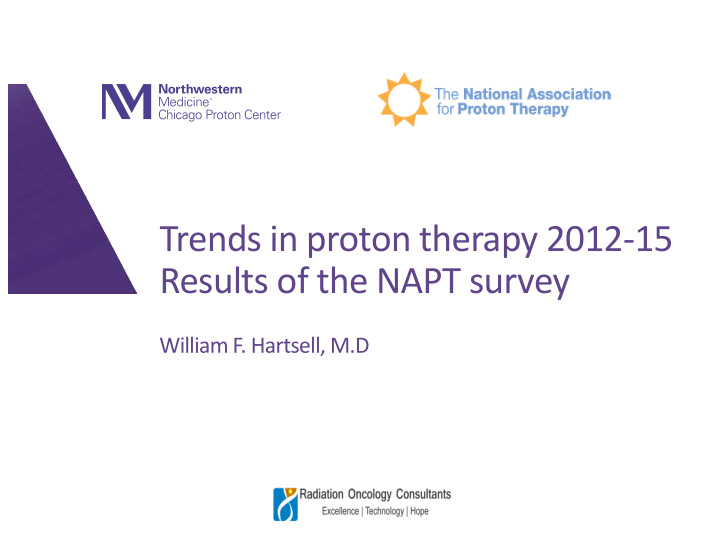



Trends in proton therapy 2012-15 Results of the NAPT survey William F. Hartsell, M.D
NAPT Survey Tool
Proton Therapy Centers in the US - 2015 WA 2013 ME MT ND 2002 OR VT MN NH ID WI SD MI NY MA RI 2015 CT WY 2012 PA IA NJ NE NV 2010 2015 OH MD DE IL 1994 UT IN 2010 WV CO CA VA KS MO KY 2004-14 2013 NC TN AZ OK 2014 AR 1990 SC 2010 2009 NM AL GA 2015 MS 2015 TX LA 2015 2014 2014 FL 2006 2006
Proton therapy in the United States Patients treated 9000 8000 7851 7084 7000 6000 5844 5377 5000 4762 Patients treated 4178 4000 3480 3172 3000 2000 6 7 10 10 11 13 16 19 # of centers 1000 0 2007 2008 2009 2010 2011 2012 2013 2014 2015 2016
Survey: Aggregated Survey Results Conditions treated CY 2012 CY 2013 CY 2014CY 2015 Central Nervous System 598 639 714 1,014 Intraocular Melanomas 250 260 276 296 Pituitary Neoplasms 50 64 71 44 Base of Skull or Axial Skeleton 179 239 270 232 Head and Neck 316 387 576 808 Lung Cancers 437 490 595 596 Sarcoma 16 22 16 209 Pediatric (Solid Tumors (<18) 685 749 940 1,090 Gastrointestinal Tract 170 308 427 480 Urinary Tract 13 13 24 35 Female Pelvic Organs 24 29 42 38 Prostate Cancer 2,336 2,094 2,355 2,311 Breast Cancer 93 183 319 425 Other 210 367 459 273 Subtotal 5,377 5,844 7,084 7,851 Survey respondents 11 13 16 19
Proton therapy patients Prostate Cancer 2,500 2,000 Patients treated 1,500 1,000 500 0 2012 2013 2014 2015 Calendar year
Proton therapy patients Adult CNS and Pediatric tumors 1200 1000 Number of patients 800 Pediatric (Solid Tumors (Up 600 to Age 18)) Central Nervous System 400 Tumors 200 0 2012 2013 2014 2015 Calendar year
Proton therapy patients 900 800 700 600 Number of patients 500 Head and Neck Lung Cancers 400 Gastrointestinal Tract 300 Breast Cancer 200 100 0 2012 2013 2014 2015 Calendar year
Proton therapy patients 350 300 250 Number of patients 200 Intraocular Melanomas 150 Base of Skull or Axial Skeleton 100 50 0 2012 2013 2014 2015 Calendar year
Proton therapy patients 500 450 400 350 Number of patients 300 Other 250 200 Unresectable Retroperitoneal Sarcoma 150 100 50 0 2012 2013 2014 2015 Calendar year
Proton therapy patients 500 450 400 350 Number of patients 300 Other 250 200 Unresectable Sarcoma Retroperitoneal Sarcoma 150 100 50 0 2012 2013 2014 2015 Calendar year
Levels of Complexity for Treatment Delivery 2012 2013 2014 2015 CPT 77520 1,078 1,045 1,416 1,346 CPT 77522 58,260 48,876 40,620 45,086 CPT 77523 62,321 69,552 95,551 108,232 CPT 77525 15,369 20,662 28,741 26,890 Subtotal 137,028 140,135 166,840 181,964 Survey respondents 9 11 14 16 Hartsell - Proton therapy numbers
Trends in Proton Therapy 1990-2016: Type of treatment room
Trends in Proton Therapy 1990-2016: Type of treatment beam 40 35 30 Number of treatment rooms 25 Double scatter 20 Uniform scanning Pencil beam scanning 15 10 5 0 1990 1995 2000 2005 2010 2015 2020 Year
Conclusions: NAPT survey data • The number of patients treated with protons is gradually but steadily increasing – approximately 7,850 patients were treated with protons in the US in 2015 • The number of patients treated for “traditional” indications for protons – pediatrics, brain – continues to gradually increase, although there has been minimal increase in base of skull tumors, and intraocular melanoma. • There is a shift to “new” disease sites treated, especially with an increase in breast, lung, head & neck, gastrointestinal tumors • The total number of patients with prostate cancer has remained relatively stable - Despite additional new centers - Relative frequency has decreased from 43.4% in 2012 to 29.4% in 2015 • Complexity of treatments in gradually increasing over time (especially intermediate) • Not listed - retreatment – this may be substantial number of patients • Strong trend toward pencil beam scanning, away from US or DS
Acknowledgements All centers for contributions to the data NAPT/ MWE • MD Anderson • Jason Caron • Northwestern Medicine Chicago • Deborah Godes Proton Center • Heather Garecht • ProCure – New Jersey • Todd Ketch • ProCure – Oklahoma City • James Metz, M.D. • Provision Center for Proton Therapy • Minesh Mehta, M.D. • Robert Wood Johnson – New Jersey All centers for contributions to the • Seattle Proton Center data • Scripps • Ackerman Cancer Center • Texas Center for Proton Therapy • Hampton Univ. Proton Therapy • Univ. of California San Francisco Institute • Univ. of Florida Proton Therapy • Indiana Univ. Health Proton Institute Therapy Center • Univ. of Pennsylvania Health System • Loma Linda Univ. Medical Center • Washington/Barnes Jewish • Massachusetts General Hospital • Willis Knighton • Mayo Clinic Rochester
Recommend
More recommend